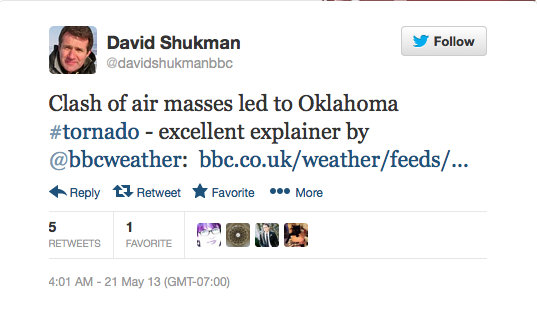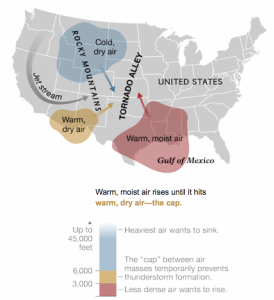Tornadoes and the “Clash of the Air Masses”
Ever seen media reports talk about how tornadoes form in the central United States? It always seems to start with warm air from the south meeting cold air from the north. Need some examples? How about these?
USA Today: http://www.usatoday.com/story/news/nation/2013/06/08/oklahoma-tornadoes-ef5-moore/2401885/
The Independent: http://www.independent.co.uk/news/tornado-disaster-clash-of-air-masses-in-tornado-alley-1091490.html
KTBC Fox News, Austin, Texas: http://www.myfoxaustin.com/story/21871999/weather-facts-tornado-rotation
National Geographic: http://ngm.nationalgeographic.com/2013/11/biggest-storm/tornado-formation
I think the saddest thing about the National Geographic article and web site being wrong is that this was in association with an article about the death of storm chaser Tim Samaras.
Wikipedia is not immune either (accessed 26 November 2013):
In the middle latitudes, where most tornadoes of the world occur, the Rocky Mountains block moisture and buckle the atmospheric flow, forcing drier air at mid-levels of the troposphere due to downsloped winds, and causing the formation of a low pressure area downwind to the east of the mountains. Increased westerly flow off the Rockies force the formation of a dry line when the flow aloft is strong,[63] while the Gulf of Mexico fuels abundant low-level moisture in the southerly flow to its east. This unique topography allows for frequent collisions of warm and cold air, the conditions that breed strong, long-lived storms throughout the year.
I am amused that the same media that were drooling for the opportunity to travel with VORTEX2 to collect data to better understand tornado development are the ones that don’t even read their own past stories when the next tornado outbreak happens. It’s back to the old chestnut: “colliding air masses.”
Well, several of us have been quite frustrated by the lack of accurate science on tornadoes getting into the media stories. Yvette Richardson, Paul Markowski, Chuck Doswell, and I just submitted this paper to the Bulletin of the American Meteorological Society addressing this issue. Whether this article has any impact, I don’t know.
But, we meteorologists should demand better from our media. And, the public should, as well.
UPDATE (9 March 2014): Here is the latest version.





I haven’t read your article yet, but I hope to over the coming weekend. At any rate, I hope you make two things clear: 1) why this myth has become ubiquitous and 2) a straight-forward explanation for the media that is plainly obvious in your paper. For 1), I believe this is because the major outbreaks virtually always involve synoptic-scale air masses with large temperature contrasts. For 2), I think this is essential so those in the media that grab a hold of this article can be pointed to the right place immediately, as undoubtedly you will have the “rip and readers” looking for this information. It sounds like this article is well overdue, so thanks for pursuing it!
Thanks for your comment, Matt. I wish I knew where the myth came from and why it has been the go-to media explanation.
Paul and Yvette published a straightforward explanation of tornadogenesis in their Weatherwise article, so we don’t really duplicate that in this article.
http://www.weatherwise.org/Archives/Back%20Issues/2013/July-August%202013/torando_full.html
Looking forward to your feedback on the paper.
You and your coauthors did a very good job writing this paper. I like that you point out that the so-called clashing of air masses actually can lead to a reduced chance of tornadoes; and in addition you refute the clash of air mass notion on both the synoptic scale and storm scale. If you want to add another example on p. 8 (lines 165-177) I’m sure you could could come up with tornadic supercells initiated in areas of orography but in the absence of fronts. Last, I still maintain that it would be useful to have a sidebar (perhaps noted in the Conclusion) that basically says “Use ‘________’ to explain tornadogenesis instead of the clashing of air mass reasoning,” but that is just my preference. The hard part will be making it short enough such that it will be adopted by the media in place of the outdated “clashing of air masses” 6-sec sound byte.
Dave,
This “clash of air masses” rubbish has been a pet peeve in media stories for years, but so ubiquitous that I’m nearly numb to it now. How unfortunate is that? Thank you and your co-authors for assembling in formal form what many of us have had in our heads for a long time. I don’t have anything major to add or criticize there; you all have covered the issue very well.
I’d like to add a minor example to Matt’s: warm-sector tornadic supercells well-removed from baroclinic zones (surface or aloft). The 3 May 1999 and 27 April 2011 outbreaks each contained some notorious examples; and even storm-scale surface baroclinicity was feeble with Storm A (3 May 1999) as Marko has noted before. I’m glad you brought up the weakly baroclinic tropical cyclone setting also.
Hi David,
I just read the submitted paper on the issue of tornadoes and the media’s mantra invoking the “clashing of air masses.” Couldn’t agree more. During my 28 years of teaching at Penn State, I always stressed this in class. I wrote a blog on this very issue at Weather Underground back in July.
http://www.wunderground.com/blog/24hourprof/comment.html?entrynum=58
Enjoy your Web site.
Lee Grenci
(Retired)
Nice entry, Lee! Thanks for doing that. Alas, even some other science BLOGs are not as careful. It’s not just the popular media perpetuating the “clash of air masses” misconception…
http://www.livescience.com/29691-big-city-tornadoes-100917.html
Thanks Roger! Good to hear from you!
Lee
I think you all should spend less time worrying about a phrase and more time developing and testing your own models.
That’s my opinion.
http://www.solvingtornadoes.com